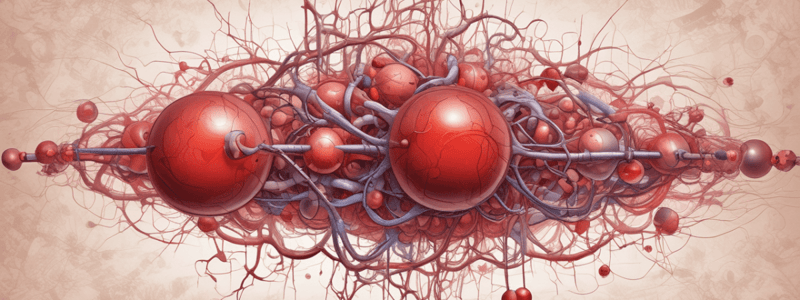Podcast
Questions and Answers
What is the result of a deficiency of Protein C or S?
What is the result of a deficiency of Protein C or S?
- Excessive clotting (correct)
- Normal clotting
- Excessive bleeding
- No clotting at all
Which of the following is a characteristic of a mutated Factor V?
Which of the following is a characteristic of a mutated Factor V?
- It is an autosomal recessive disorder
- It cannot be inhibited by Protein S or C (correct)
- It can be inhibited by Protein S or C
- It only affects females
What is the pattern of inheritance of a deficiency of Factor VIII or IX?
What is the pattern of inheritance of a deficiency of Factor VIII or IX?
- Mitochondrial
- Autosomal recessive
- Autosomal dominant
- X-Linked (correct)
What is the result of a deficiency of Antithrombin?
What is the result of a deficiency of Antithrombin?
What is the diagnostic test result for a deficiency of Factor VIII or IX?
What is the diagnostic test result for a deficiency of Factor VIII or IX?
What is the presentation of Deep Tissue Bleeding?
What is the presentation of Deep Tissue Bleeding?
What is the primary mechanism of action in ITP that leads to thrombocytopenia?
What is the primary mechanism of action in ITP that leads to thrombocytopenia?
Which of the following statements is true about Von Willebrand factor?
Which of the following statements is true about Von Willebrand factor?
What is the characteristic of bleeding in Hemophilia A?
What is the characteristic of bleeding in Hemophilia A?
What is the primary cause of hemolytic anemia in DIC?
What is the primary cause of hemolytic anemia in DIC?
Which of the following is a characteristic of ITP?
Which of the following is a characteristic of ITP?
What is the role of endothelium in DIC?
What is the role of endothelium in DIC?
Which of the following is NOT a characteristic of Hemophilia A?
Which of the following is NOT a characteristic of Hemophilia A?
What is the primary mechanism of action in DIC?
What is the primary mechanism of action in DIC?
Flashcards are hidden until you start studying
Study Notes
Platelet Disorders
- Immune Thrombocytopenic Purpura (ITP): Weak platelet plug leading to superficial bleeding due to autoimmune process, resulting in increased destruction of platelets.
- Mechanism of action: Autoantibodies against platelet receptors, leading to platelet destruction by macrophages in the spleen, causing thrombocytopenia.
Von Willebrand Factor Disorder
- Weak platelet plug leading to superficial bleeding due to impaired platelet function, caused by a deficiency of Von Willebrand Factor.
- Mechanism of action: Low amount of Von Willebrand Factor, impairing platelet adhesion to collagen, leading to superficial bleeding with normal platelet count.
- Additional effect: Decreased factor VIII, causing prolonged PTT.
Coagulation Disorders
- Hemophilia: Insufficient production of fibrin mesh, leading to deep tissue bleeding.
- Mechanism of action: Deficiency of factor VIII (Hemophilia A) or factor IX (Hemophilia B), leading to reduced fibrin production and deep tissue bleeding.
Mixed Disorders
- Disseminated Intravascular Coagulation (DIC): Widespread activation of platelets and coagulation factors, leading to excessive clotting and bleeding.
- Mechanism of action: Proinflammatory cytokines damage endothelium, releasing tissue factor and Von Willebrand Factor, leading to widespread clot formation, organ ischemia, and hemolytic anemia.
- Later stages: Consumption of platelets and fibrin leads to bleeding.
Inherited Thrombophilia
- Deficiency of Protein C or S, leading to unregulated clotting.
- Deficiency of Antithrombin, leading to unregulated clotting.
- Mutated Factor V, leading to resistance to Protein S or C, causing excessive clotting.
Patterns of Inheritance
- Autosomal Dominant: Inherited thrombophilia affects both men and women, with a single inherited gene.
- X-Linked Disorder: Hemophilia affects mostly males, in all ethnic groups, with females as carriers.
Studying That Suits You
Use AI to generate personalized quizzes and flashcards to suit your learning preferences.




